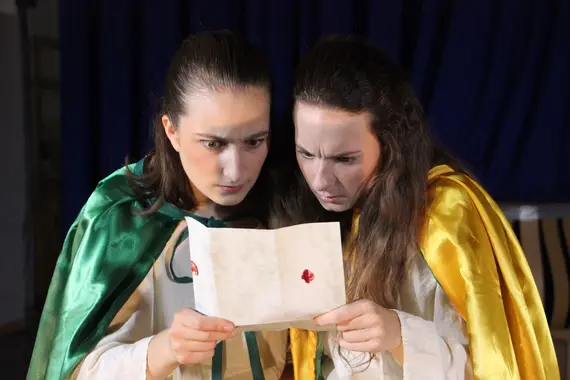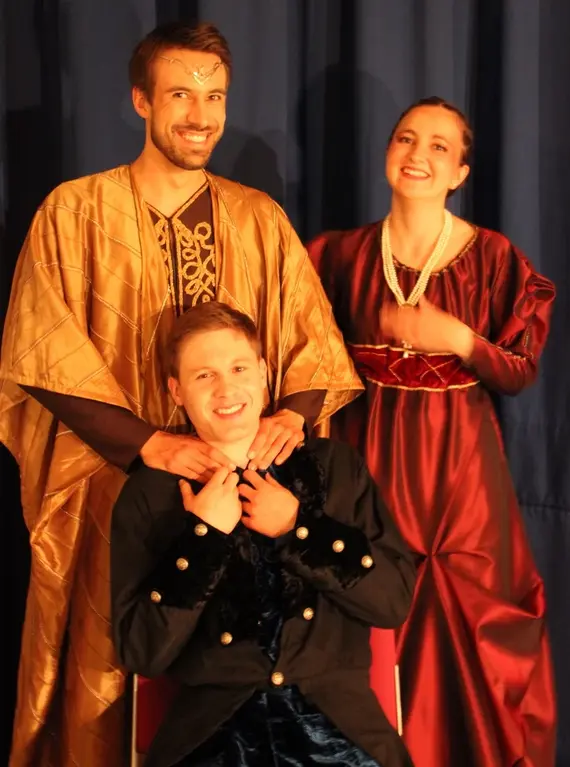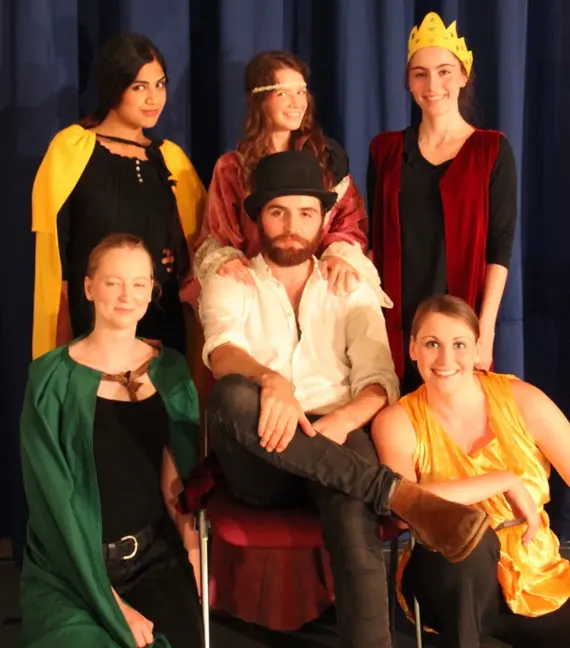Review
by Anne Haberländer and Carina Hümmer; photos: Alice Limmer
From the 18th to the 23rd of July, Tom Stoppard’s play Rosencrantz and Guildenstern are Dead was performed at the JuZ (Jugendzentrum) in Bamberg. The play was staged by the Bamberg University English Drama Group under the direction of Alice Limmer. The absurdist tragicomedy tells the story of Rosencrantz and Guildenstern, who are minor characters in Shakespeare’s tragedy Hamlet.
The play follows the plot of Shakespeare’s Hamlet. Whereas Hamlet, Ophelia and Shakespeare’s other main characters have merely minor roles, Rosencrantz (Rebekka Baumann) and Guildenstern (Alicia Drefs) are brought centre-stage. However, they are still consigned to the margin of Shakespeare’s action as it now happens off-stage. The audience follows Hamlet’s childhood friends, who are mirror characters of each other, while the tragedy unfolds in the rotten state of Denmark. As they remain in the dark and do not know Hamlet’s thoughts, Rosencrantz and Guildenstern pass their time playing games and discussing existential questions. While the dialogues are often repetitive and seemingly dull, they are also witty and profound. All in all, a juxtaposition is created by the fact that Rosencrantz and Guildenstern lament about their position in the play while the audience is familiar with their predetermined fate.
With only a few but detailed props and sustained dialogues in the first scene, which only shows the two main characters, their state of mind was conveyed upon the audience. This monotony was broken by the Player (Daniel Rooney) and his group of actors. Change between monotony and comic relief occurred frequently. Rebekka Baumann and Alicia Drefs made a good team: the more light-hearted and simpler Rosencrantz and the serene and intellectual Guildenstern. The two actors reflected these character traits perfectly, thereby creating many funny situations. In their verbal duels, especially during the scenes where they pretended to be the king of England, the two actors showed wonderful verbal timing. Furthermore, Daniel Rooney stood out by brilliantly enacting the provocative Player. His Scottish accent and witty verbal back-and-forth with Rosencrantz and Guildenstern spiced up the performance. The character also discussed what it means to be an actor and therefore exploited the subject of metatheatre. His pretend death scene at the end of the play was an incredibly dramatic performance and had the audience wondering what is going on.
The group did a wonderful job with their costumes. Rosencrantz and Guildenstern wore puffy trousers in reversed colours – one wearing green on yellow, the other wearing yellow on green – which again reflects the mirror image. The costumes worn by the original protagonists in Hamlet stood out with a different colour palette creating a more flamboyant look.
Throughout the play, few props were used, and the scenery was simple. In the scenes of the last act, where the plot climaxes, the boat which is supposed to take Hamlet and the two main characters to England, is staged in more detail. The scenery and mood the group created in the boat scenes were very effective and formed a contrast to the rest of the play. Lighting effects added to the surreal atmosphere during the pirate attack where the lights flashed, and likewise did the sound effects. All in all, the difficult play was well adapted by the BUEDG and especially rewarded lovers of Shakespeare with little Easter Eggs.


